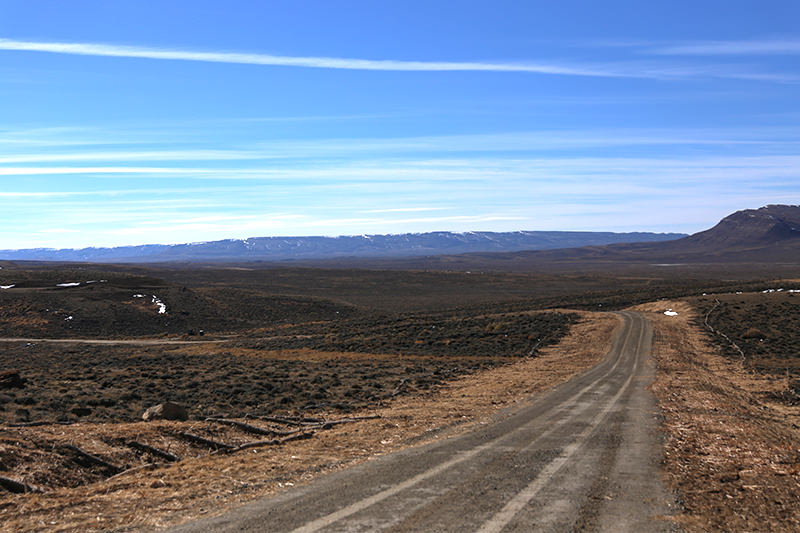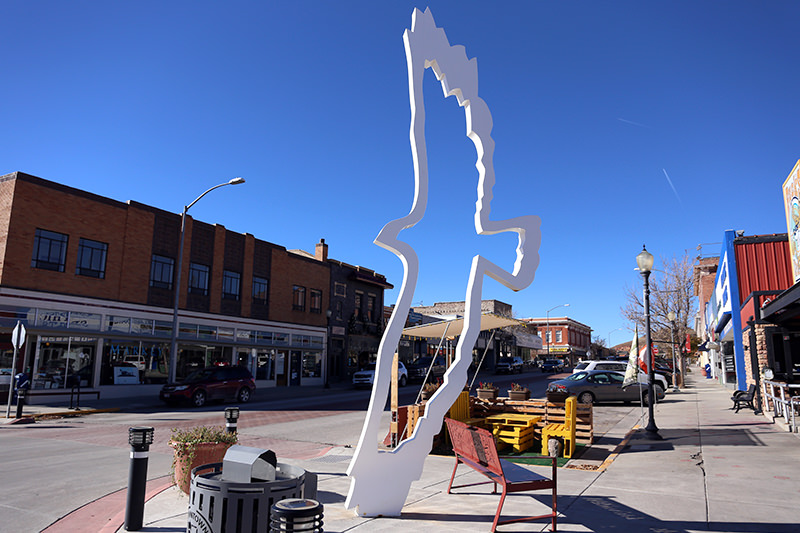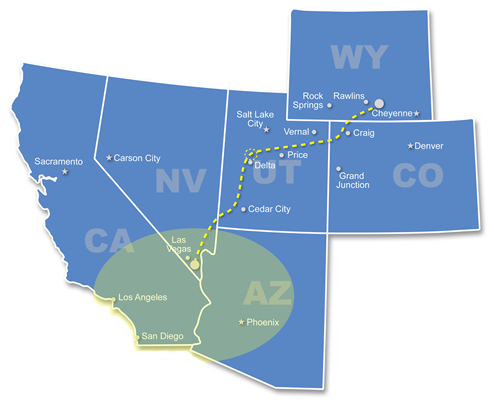This story is part of a new Rocky Mountain Community Radio reporting collaborative on the transition away from fossil fuels.
Jason Theesfeld drove a white pickup truck over a network of newly-built dirt roads winding through sagebrush and native grasses on a recent Friday. The landscape was colored the brown of late fall in the West and appeared as almost a textbook definition of the wide open spaces Wyoming is famous for.
“Last year, there was not a road through here. It was almost like you’d have to ride a horse to get across this country,” Theesfeld said. “And I just passed my turn. So, there are so many new roads I can’t even remember where I’m going.”

A view of part of the Chokecherry and Sierra Madre Wind Energy Project site overlooking Miller Hill, the far ridgeline, which boasts some of the best on-shore wind resources in the U.S. (Kyle S. Mackie/KHOL)
Theesfeld is site coordinator of the Chokecherry and Sierra Madre Wind Energy Project for the Power Company of Wyoming. He’s been working on the 320,000-acre project site near Rawlins, in south-central Wyoming, for almost 15 years, long before construction started in 2016. That’s because this project required more environmental analysis than your average wind farm.
“We know everything about the site: The wind, the vegetation, the habitat, the wildlife, where things live, where things move, where the wind blows,” said Kara Choquette, the company’s director of communications. “It’s a huge science project, really.”
Chatting from her seat in the back of the pickup, Choquette said the Chokecherry and Sierra Madre project is probably one of the most scrutinized wind farms in the country because of its location on Bureau of Land Management (BLM) land.
“It’s just a fact that when you are doing energy projects on federal land, there’s more environmental review, more environmental scrutiny, therefore more time, more costs, and that’s just how it is,” she said.

Downtown Rawlins, Wyoming, is home to a pair of hawk sculptures created by the Denver artist Josh Wiener that are inspired in part by Wyoming’s status as a leader in wind energy. (Kyle S. Mackie/KHOL)
Tom Darin is senior director of Western state affairs for the American Clean Power Association, the largest wind trade association in North America. He said about 97-98% of U.S. wind farms are located on private property, in part because of the additional environmental planning and permitting processes it takes to build on public land.
“It does take a while. It does need to go more quickly,” Darin said, but, “We need to tap into the great wind and solar resources that are on our public lands in the Western United States.”
That need exists not only because some of the country’s best wind and solar resources are located on federal lands, but also because Congress set an ambitious goal last year of permitting 25 gigawatts of renewable energy projects on public lands by 2025. The current capacity of permitted projects is about 12 gigawatts, according to the BLM.

A map shows the planned route of the TransWest Express transmission line, as per a 2005 Memorandum of Understanding signed by regional governors. (TransWest Express LLC)
The Chokecherry and Sierra Madre site will generate at least 3,000 megawatts of clean electricity once it’s completed—more than the Hoover Dam—but another federal agency is standing in the way of how that electricity will reach customers via the planned TransWest Express transmission line. That line will eventually terminate at the Hoover Dam after stretching 730 miles from Wyoming across Colorado, Utah and Nevada. From there, the electricity will serve customers in California and across the Southwest.
“I guess it’s disappointing [in] that there was so much collaboration to develop the route for the project,” Choquette said, “the TransWest project was designated a Rapid Response Team [for Transmission] federal priority transmission project by the Obama administration 10 years ago, and [yet] the last mile and the last obstacle is a federal agency.”
The Los Angeles Times reported in August that the last private landowner blocking the construction path for TransWest Express is Cross Mountain Ranch in northwest Colorado. The family is backed by the Natural Resources Conservation Service (NRCS), which is part of the U.S. Department of Agriculture (USDA). Basically, the BLM approved a path for TransWest Express across part of the ranch in 2013, but then in 2014, the NRCS approved conservation easements in the same area that prohibited the construction of transmission lines.

Gateway West, a separate transmission line under construction by PacifiCorp and Idaho Power, runs through the Chokecherry and Sierra Madre Wind Energy Project site. (Kyle S. Mackie/KHOL)
Court filings also appear to show that NRCS officials knew the ranch was requesting the easement specifically in order to block the transmission line—not only to protect sage grouse habitat. KHOL asked Choquette whether she thought the easement siting was a reflection of the conflict between the Biden administration’s dual goals of investing in clean energy projects while also conserving at least 30% of the country’s lands and waters by 2030.
“There is no conflict, except the one that the NRCS created,” she said. “The TransWest project would cross the conservation easement on land that is not great sage grouse habitat. It’s a 16,000-acre conservation easement. The project needs 30 acres alongside a state highway.”
After years of trying to resolve the dispute without legal action, Choquette said the company had no choice but to file a lawsuit against the USDA in 2019. That’s still playing out, but the company is hoping for a decision soon—preferably long before the first of about 900 wind turbines start going up on the Chokecherry and Sierra Madre project site in 2025 or 2026.
“I feel like, ‘What are we waiting for?’” Choquette said. “If the goal is to help solve or help address climate issues and decarbonize the [power] grid, we don’t have time to lose.”
EDITOR’S NOTE: A deal was reached on Dec. 22, 2021, that will allow the TransWest Express and PacifiCorp’s Gateway South transmission lines to traverse Cross Mountain Ranch pending formal approval from the U.S. Department of Agriculture. Bloomberg first reported the settlement on Dec. 28.






